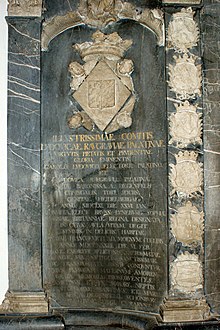Luise Raugräfin zu Pfalz
Luise Raugräfin zu Pfalz (born January 26, 1661 in Heidelberg ; † February 6, 1733 in Frankfurt am Main ) was a daughter of Elector Karl I. Ludwig of the Palatinate. The letters that her half-sister Elisabeth Charlotte - known as Liselotte von der Pfalz - wrote to her, created an immortal monument to her.
biography
Luise was the second eldest daughter from the union of the Palatine Elector Karl I. Ludwig (1618–1680) and his morganatically wedded wife Marie Luise von Degenfeld . She was Liselotte's favorite sister, as evidenced by the confidential tone of the letters addressed to her.
For lack of a dowry, she was forced to lead an unsteady wandering life with her sister Amalie Elisabeth, called Amelise , who was two years her junior . Her travels took her to London (July 1696 - July 1697), Eisenach , Kassel , Berlin and Hanover . There she worked briefly as the Grand Chamberlain of her aunt Sophie von der Pfalz , Electress of Hanover. When she consulted Gottfried Wilhelm Leibniz on the question of succession for the British crown , Luise was one of Leibniz's correspondence partners in 1712.
After the death of her brother Karl Ludwig Raugraf zu Pfalz with great effort , she managed to manage the Streichenberg castle with the village of Stebbach (now part of the Gemmingen municipality in the Heilbronn district ) as a kunkellee , and managed it with great business acumen. In addition, she took care of the property of her brother-in-law Meinhard von Schomberg, who had moved to England .
Luise was a committed Calvinist and founded a Reformed prayer house in Hanover. She took care of Huguenot refugees who fled from France after the edict of Fontainebleau was issued and - in cooperation with her sister-in-law Liselotte - she was involved in the release of 184 people, including many preachers. T. had been held for years on French galleys.
Luise spent her last years very withdrawn. She had survived all of her 12 siblings and with her death in 1733 the Raugrafen family died out . She was transferred from the place where she died, Frankfurt am Main, to Heidelberg, where she was buried next to her sister Amelise in St. Peter's Church and was honored with a black marble grave monument that still exists today.
literature
- Johann Friedrich August Kazner: Louise, Raugräfin zu Pfalz, née Freiin von Degenfeld , 3 vols., Leipzig, 1798.
- Wolfgang Menzel (Ed.): Letters from Princess Elisabeth Charlotte v. Orleans to the rough countess Louise 1676-1722. Library of the Literary Association in Stuttgart, 1843.
- Margarete Knebel: Liselotte's relatives. The extensive family tree of Liselotte von der Pfalz. Weinheim: ABT Druck, 1995.
- Sigrun Paas (Ed.): Liselotte from the Palatinate. Madame at the court of the Sun King [Exhibition by the city of Heidelberg for the 800th anniversary, September 21, 1996 to January 26, 1997 in Heidelberg Castle]. Heidelberg: HVA, 1996
| personal data | |
|---|---|
| SURNAME | Luise Raugräfin zu Pfalz |
| BRIEF DESCRIPTION | Raugräfin zu Pfalz |
| DATE OF BIRTH | January 26, 1661 |
| PLACE OF BIRTH | Heidelberg |
| DATE OF DEATH | February 6, 1733 |
| Place of death | Frankfurt am Main |

